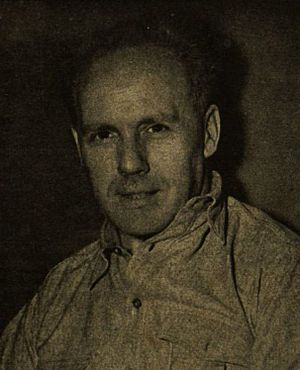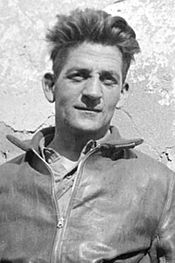Seán Russell facts for kids
Quick facts for kids
Seán Russell
|
|
|---|---|
 |
|
| Chief of Staff of the IRA | |
| In office 1938 – April 1939 |
|
| Preceded by | Mick Fitzpatrick |
| Succeeded by | Stephen Hayes |
| Personal details | |
| Born | 13 October 1893 41 Lower Buckingham Street, Dublin, Ireland |
| Died | 14 August 1940 (aged 46) U-65, Atlantic Ocean, 100 miles (160 km) off Galway, Ireland |
| Military service | |
| Branch/service |
|
| Battles/wars | |
Seán Russell (born October 13, 1893 – died August 14, 1940) was an important figure in Irish Republicanism. He took part in the Easter Rising in 1916. He also held senior roles in the Irish Republican Army (IRA) during the Irish War of Independence and the Irish Civil War.
From 1938 to 1939, Russell was the Chief of Staff of the IRA. Under his leadership, the IRA started the Sabotage Campaign. This involved bombing buildings and important places in the United Kingdom, mostly in England. During this time, Russell also worked with Nazi Germany. In 1940, he traveled to Germany. He met with a German foreign minister and trained with explosives. In August 1940, Russell was supposed to return to Ireland as part of a secret plan. However, he became sick and died on a German submarine. He was then buried at sea.
Contents
Seán Russell's Early Life
Seán Russell was born John Angelo Russell in Dublin in 1893. He was one of ten children. His parents, James and Mary, were from County Westmeath.
Fighting for Irish Freedom
Russell joined the Irish Volunteers in 1913. This group wanted Ireland to be independent from British rule.
The Easter Rising
In 1916, Russell fought in the Easter Rising in Dublin. He was a section commander and helped lead fighters at the Metropole Hotel. After the Rising, he was held in special camps. In 1919, he joined the Irish Republican Army (IRA).
The War of Independence
When the Irish War of Independence began, Russell became the IRA's Director of Munitions in 1920. This meant he was in charge of weapons and supplies. He was also involved in planning a major event on Bloody Sunday in 1920.
The Irish Civil War
During the Irish Civil War, Russell fought against the Anglo-Irish Treaty. This treaty created the Irish Free State but kept Ireland connected to Britain. Russell was held in prison for a long time after the war ended. While in prison, he went on a hunger strike for 41 days. In 1925, he escaped from Mountjoy Prison after helping to plan the breakout.
After the Civil War
After the Civil War, Russell wanted the IRA to continue its fight. In 1925, he traveled to the Soviet Union to try and buy weapons for the IRA. He became the IRA's Quartermaster General in 1927, staying in that role until 1936. He spent time traveling around Ireland, helping to reorganize the IRA.
In 1934, Russell met with Éamon de Valera, who was the leader of the Irish Free State. They talked about the IRA possibly working with the government. Russell was open to the idea, but they could not agree on the terms.
In 1936, Russell wrote to the German ambassador in the United States. He offered to work with Germany if they ever went to war.
Leading the IRA
In 1938, Seán Russell became the Chief of Staff of the IRA. This was a very important leadership role. Some other IRA leaders disagreed with his plans and left the group. Russell and his supporters believed that a bombing campaign in England was the way forward.
The Sabotage Campaign
Before starting the bombing campaign, Russell tried to make the IRA seem more official. In 1939, some former members of the Second Dáil (an early Irish parliament) gave their authority to the IRA. This made the IRA feel they had the right to declare war on the United Kingdom. The Sabotage Campaign began soon after, with bombs in several English cities.
Russell in the United States
In April 1939, Russell traveled to the United States. He wanted to show that he was the leader of Irish nationalism. He gave many public speeches. American officials watched him closely. He was even stopped at the border during a visit by the British King. This caused a big protest among Irish-Americans.
While in the US, Russell met with Joseph McGarrity, a leader of the Irish-American group Clan na Gael. Russell also made contact with German agents to arrange his travel to Germany.
Working with Nazi Germany
Russell arrived in Berlin, Germany, in May 1940. He was treated like a diplomat and given a car and a villa. He met with important German officials, including the German foreign minister.
Russell began training with German intelligence in May 1940. He learned how to use the latest German explosives. He trained for over three months, preparing for a mission back in Ireland.
Operation Dove and Russell's Death

In July 1940, another IRA man, Frank Ryan, was brought to Germany. On August 8, Russell and Ryan left Germany on a German submarine called U-65. This mission was called Operation Dove.
During the trip, Russell became very ill with stomach pains. There was no doctor on the submarine. He died on August 14, about 100 miles from Galway, Ireland. He was then buried at sea. The mission was stopped. An investigation later found that Russell died from a burst stomach ulcer.
Some people have created conspiracy theories about Russell's death, suggesting he was poisoned or murdered. However, Russell's brother later confirmed that Seán had stomach problems before.
Seán Russell's Legacy
Seán Russell's story is still debated today. Many Irish republican groups see him as a hero who fought for Ireland's freedom. Groups like Sinn Féin and Republican Sinn Féin still honor him.
However, many others criticize him for working with Nazi Germany. They call him a Nazi collaborator. Some historians say that Russell cared more about getting weapons for Ireland than about Nazi ideas. They also say he was politically naive.
In 1958, a German official who met Russell said that Russell disagreed with Nazi ideas. Russell told him, "I am not a Nazi. I’m not even pro-German. I am an Irishman fighting for the independence of Ireland." He said he would accept German help only if it helped Ireland become independent, with "no strings attached."
Historians like Brian Hanley and Gerard Shannon believe Russell was not a Nazi. But they agree he was "politically blind" to the dangers of working with the Nazis.
In 2003, Mary Lou McDonald, a leader of Sinn Féin, spoke at a rally honoring Russell. In 2020, she was criticized for this by other politicians. She said Russell was "misguided" but did not regret attending the rally. She said he was a "militarist" but not a "Nazi collaborator."
Attacks on Russell's Memorial
A statue honoring Seán Russell was put up in Fairview Park, Dublin, in 1951. Many Irish republicans attended the unveiling.
The statue has been damaged many times.
- In 1952, paint was smeared on it.
- In 1953, its arm was broken off by a group who said it looked like a communist salute. The arm was replaced pointing down.
- On December 31, 2004, the statue's head was removed by an anti-fascist group. Its forearm was also taken.
After these attacks, the statue was rebuilt in stronger bronze in 2009 to stop vandals. The new statue might even have alarms and a GPS tracker. The original pieces of the statue were later found and rebuilt in another village.
In July 2009, the statue's base was spray-painted with graffiti saying Russell was a Nazi.
In June 2020, Leo Varadkar, a political leader, suggested the statue might need to be removed because Russell worked with the Nazis. Later that month, the statue's base was painted with the colors of the Rainbow flag. The paint was later removed.
See also
Sources
- Culleton, Brendan & Maldea, Irina, Seamróg agus Swastica (English: Shamrock & Swastika), Dublin (Akajava Films), 2002. (Broadcast on TG4, 24 January 2002).
- Hanley, Brian, The IRA. 1926–1936, Dublin (Four Courts Press), 2002. ISBN: 1-85182-721-8
- Terence O'Reilly, Hitler's Irishmen, (Mercier Press), 2008 ISBN: 1-85635-589-6
- Mark M. Hull, Irish Secrets. German Espionage in Wartime Ireland 1939–1945 2003. ISBN: 978-0-7165-2756-5
- Enno Stephan, Spies in Ireland 1963. ISBN: 1-131-82692-2 (reprint)
- Carolle J. Carter, The Shamrock and the Swastika 1977. ISBN: 0-87015-221-1
- Detroit Free Press, 7 June 1939, page 11, "Irish Chieftain Is Kept In Jail".





